The 10 Best Running Shoes for Men
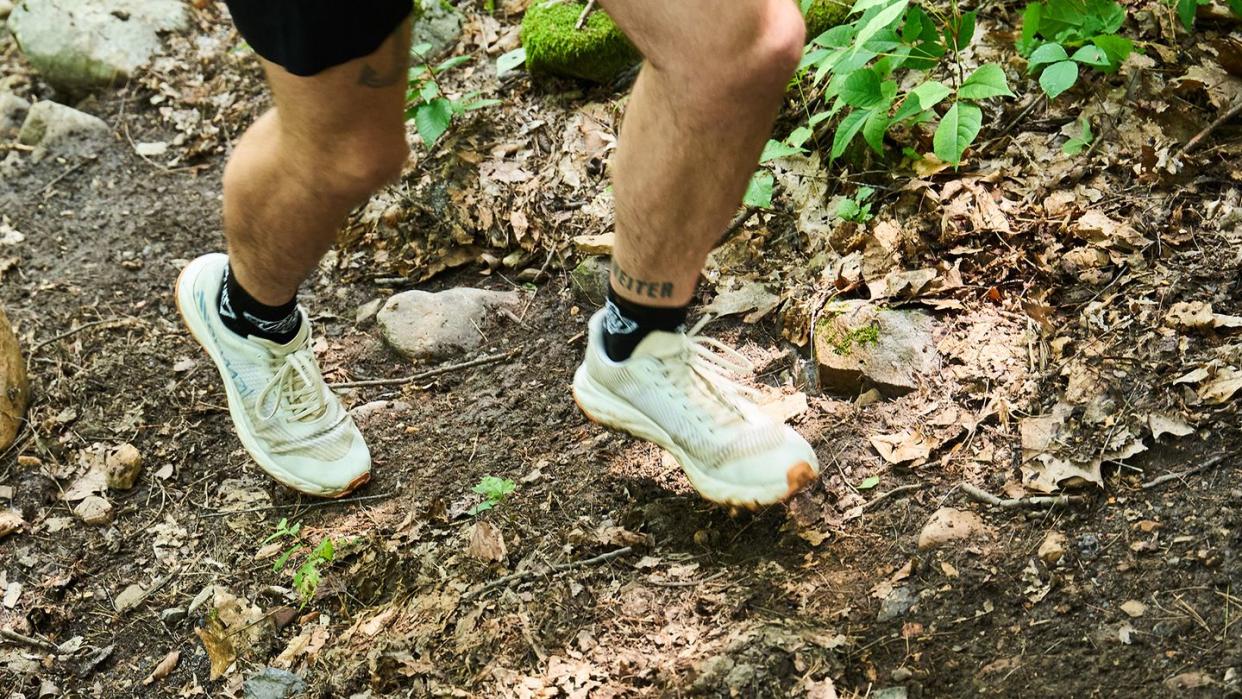
"Hearst Magazines and Yahoo may earn commission or revenue on some items through these links."
Editor’s Note: We revisited this guide in April, 2024, and updated our recommendations to reflect our most recent round of testing. In addition, we have replaced any shoes that are out of stock or no longer available.
Here at Runner’s World, we know a lot of guys—weird flex, we know, but men make up roughly half of the 277 members of our wear-test crew. We run with fast guys, slow guys, short guys, tall guys, guys training for the Olympic Trials marathon and guys recovering from injuries. Each of them have their own unique quirks, and we’ve seen or heard about a lot of them.
So what makes a great men’s running shoe? Frankly, it’s mostly about branding. Apart from marketing and colorways that appeal to dudes, men’s running shoes are defined by their size range. While there are some shoes with male-forward nuances in fit and construction, they are basically just running shoes that are sized for men.
The real work in picking the right men’s running shoe is more about you as an individual: The shape of your foot and the mechanics of your stride. It also often has a lot to do with where and how you run: Do you plan to use the shoe for workouts? Or for racing? Will you pound pavement or hoof it along dirt trails? If there’s anything we’ve learned from years of running and testing shoes, it’s that everyone’s different, and every guy picks his favorite shoes based on their own specific preferences.
That said, we’ve found that there are certain common factors men love in their shoes, including springy, lightweight cushioning and supple, form-fitting uppers. We’ve taken everything we’ve learned, and used it to pick the best running shoes for men.
The Best Running Shoes for Men
Best Overall: Hoka Mach 6
Best Budget: Brooks Trace 3
Best for Long Runs: On Cloudeclipse
Best Update: Asics Gel-Cumulus 26
Best for Road Racing: Nike Vaporfly 3
[table-of-contents] stripped
What to Consider in a Men’s Running Shoe
Fit
The perfect running shoe should feel comfortable the moment you slide your foot in. If something feels off, do not compromise. Regardless of the issue, those initial red flags will only grow into bigger problems with wear.
When you’re trying a new pair of shoes, look for a thumb’s width of space between your big toe and the front of the shoe. Next, lace them up and take a little jog in the store to ensure the midfoot hugs your arch without constricting it.
Finally, turn your attention to your heel: It shouldn’t be lifting off of the footbed as you toe off or rubbing against the heel collar. On that note, also make sure the laces aren’t putting pressure on the front of your ankle as you lean into the shoe.
If you’re not able to get to a running store to figure out your size before you buy, you can also measure your foot using a ruler and a sheet of printer paper. Hoka has a helpful shoe sizing guide that we’d recommend.
Stability
Great running shoes support great running form. Typically, shoes can help you feel more stable by promoting an optimal level of pronation, the natural inward movement of your foot to absorb shock while running and walking. Some runners instinctively overpronate, rolling their feet inward too much, and benefit from shoes that provide extra support to help counter that movement.
If the outsole rubber on your running shoes wears fastest on the inside edges of your heel and forefoot, you’re likely an overpronator.
Stability running shoes use firmer cushioning foams in key areas of the midsole, like a medial post. Other shoes put additional material on the edge of the sole to prevent your foot from twisting, like the GuideRails on Brooks’ Adrenaline GTS. If you don’t overpronate, you’ll likely prefer a “neutral” shoe, which doesn’t have extra support features and won’t interfere with your stride.
Cushioning
Most runners want a shoe with some cushioning to absorb the shock of your foot hitting the ground, but opinions vary quite a bit about how much padding your shoes should have.
Runners who focus on speed may prefer a firmer shoe that gives them a good feel for the ground. Others like a thick, plush midsole that absorbs impact forces and bounces back to put some pep in your step. Having extra padding is important for longer runs, because the extra cushioning can reduce aches in tired feet and joints.
In the past, competitive runners had to sacrifice some cushioning in order to minimize weight, which could shave fractions of a second off their finish times. In recent years, new, ultralight cushioning foams have upended that convention.
The Nike Vaporfly 3, one of the most cushioned shoes we’ve tested, tips the scale at only 7 ounces for a men’s size 10. Having it all doesn’t come cheap: Thick, light and responsive running shoes are often the most expensive. That said, the technology gets cheaper every year: Shoes like the On Cloudeclipse and Saucony Endorphin Speed 4 feature ultralight foams and cost less than $200.
Why Trust Us?
Runner’s World has helped dedicated runners, from sprinters and marathoners to gym rats and guys just trying to get in shape, for more than 50 years. Our essential running gear recommendations, including men’s running shorts and shoes, are based on the hard work of our test team, who test the latest and great running gear.
That testing includes taking shoes apart to analyze their materials and construction, as well as miles and miles of running. In 2024, the Runner’s World test team includes Runner-in-Chief Jeff Dengate, and Test Editors Amanda Furrer and Morgan Petruny.
In addition, the test team gathers data from the Runner’s World wear test program, a group of 277 Runner’s World+ subscribers, who test new running gear and submit feedback based on their experience.
For this guide, our recommendations were selected by test editors Jeff Dengate and Morgan Petruny, based on their testing and data from the wear test program. In addition, some of our recommendations–both the shoes themselves and our advice–come from two of our contributors, Michael Charboneau and Dan Roe.
Michael Charboneau is a freelance writer and former test editor for Runner’s World. He’s written about running gear, including shorts, for the last seven years at a number of publications, including SFGate, Men’s Journal and InsideHook.
Dan Roe is a freelance writer and former test manager for Runner’s World who has tested and reviewed dozens of running shoes (and cut several in half to see what’s inside).
How We Selected The Best Running Shoes for Men
We picked the best running shoes for men based on wear testing and data from the Runner’s World test team–specifically Runner-in-Chief Jeff Dengate–and the men of the Runner’s World wear test program. After putting countless pairs through the wringer and evaluating the data, we’ve rounded up some of the standouts that have received especially high marks and praise from our male testers. (For an even deeper breakdown of our rigorous testing process, check out how we evaluate shoes.)
Seeking tips to get the best fit and price? We’ve got you covered there, too.
Our Full Men's Running Shoe Reviews
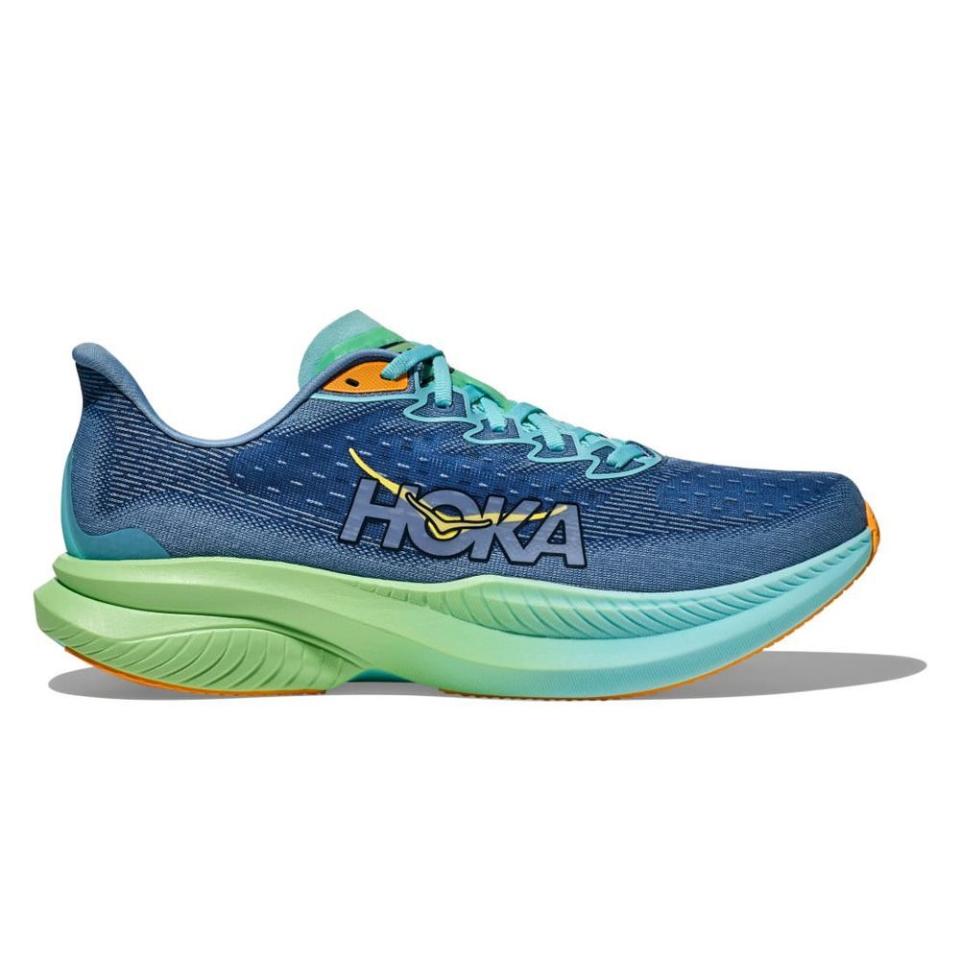
Mach 6
hoka.com
$140.00
The Hoka Mach 5 won the Runner’s World Gold Medal award for its supreme versatility as an everyday trainer: substantial enough to support you for a long run, but quick enough to spur you as you ramp up the tempo for the final few miles. It was so effective, in fact, that we got worried when we found Hoka had reworked the entire design for the Mach 6. It turns out we had no reason to worry: We love the new version too.
“The Mach is back, baby!” Runner’s World Runner-in-Chief Jeff Dengate said he’s pumped about the Hoka Mach 6. Our wear-testers were also very impressed with the new and improved design.
Hoka managed to thicken the midsole by 8mm both fore and aft without adding any weight to the shoe–that’s no small feat. The secret sauce is Hoka’s Supercritical EVA foam compound, which now composes the entire midsole, rather than only half. More porous than conventional ethylene vinyl-acetate, Supercritical makes the shoe lighter and more responsive, enabling speed without cutting out comfort.
“They feel very soft, but in a responsive way—not a sink-your-feet-in way,” said one wear-tester, a collegiate runner. “I got in some pretty solid long runs, which progressed nicely in pace, and these shoes felt great at each one of those paces.”
The company put a durable rubber back on the outsole, which should help the shoe grip better and last longer. Our testers also loved the creel jacquard upper, which puts a soft, comfortable layer of polyester near the foot and wraps that with a stretch-resistant polyester exterior to keep your foot secure. It may be too snug for wider feet, though: The shoe’s still relatively narrow, with a pointed shape that may pinch if you have a wide forefoot.
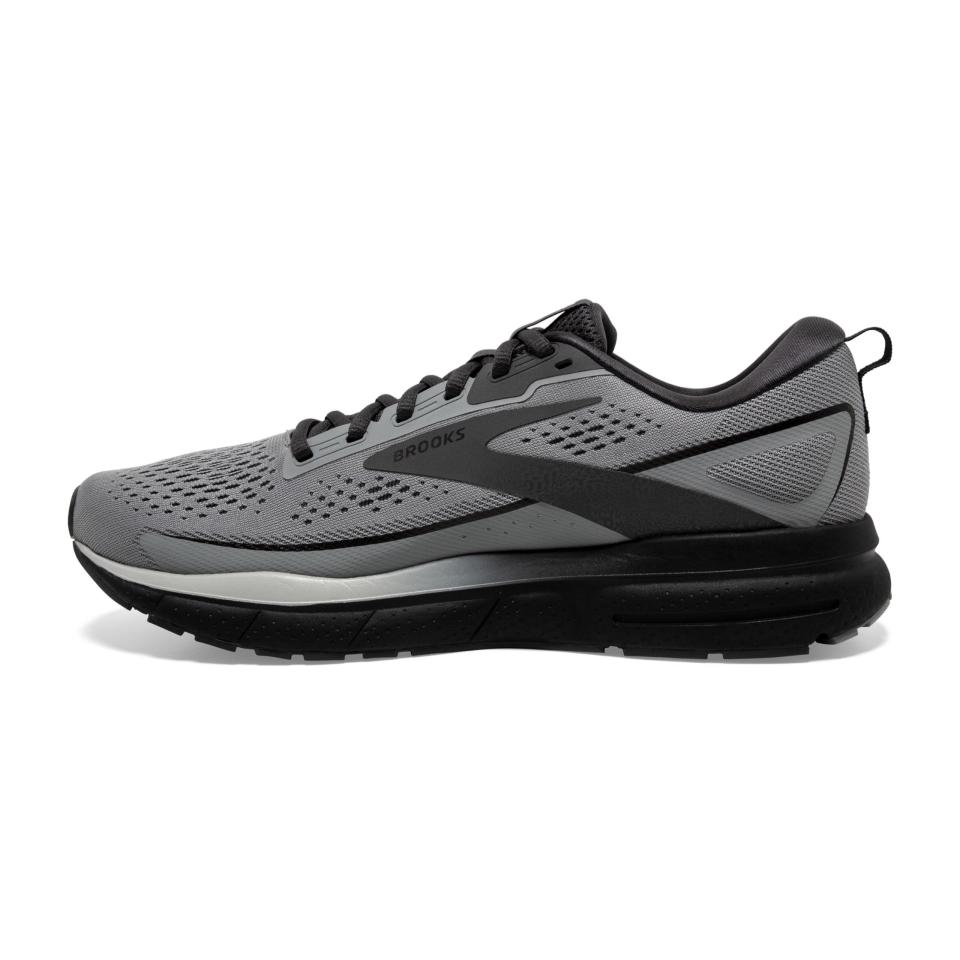
Trace 3
amazon.com
$99.95
If you’re in the market for a well-cushioned neutral running shoe that only costs $100, the Brooks Trace 3 is worth keeping in mind. As of April 2024, the Trace 3 is brand new so we haven’t been able to fully test it yet. That said, we’ve encountered shoes like it many times before–its basic components and design reflect generations of Brooks shoes that we loved for their dependable, no-nonsense comfort and support.
The Trace has historically resembled the Brooks Ghost—the brand’s flagship neutral cushioned shoe—but with a slimmer EVA foam midsole. For the latest version of the shoe, Brooks switched up the foam from its traditional EVA compound to a combination of EVA foam, rubber and air, dubbed DNA Loft. In our experience, Brooks’ DNA Loft shoes can feel a little bit lighter and more responsive underfoot than shoes with traditional EVA foam midsoles.
The shoe comes in a touch heavier than its predecessor, which is likely due to a redesigned mesh upper that uses a greater percentage of recycled materials and adds a heel pull tab that makes the shoe easier to slide on your foot. Like the rest of Brooks’ road running shoe lineup, the Trace 3 features a soft engineered mesh upper that includes ample foam at contact points like the ankle collar and tongue.
The outsole sports redesigned flex grooves that take the edge off the heel-toe transition, which should help the shoes avoid feeling blocky—a critique from the previous version of the Trace.
So far, the Trace 3 has garnered positive early reviews from runners, who note the shoe’s ability to keep runners comfortable for training runs long and short. For runners who don’t need additional stability and want to stack up training run mileage without expensive shoe replacements, start with the Brooks Trace 3.
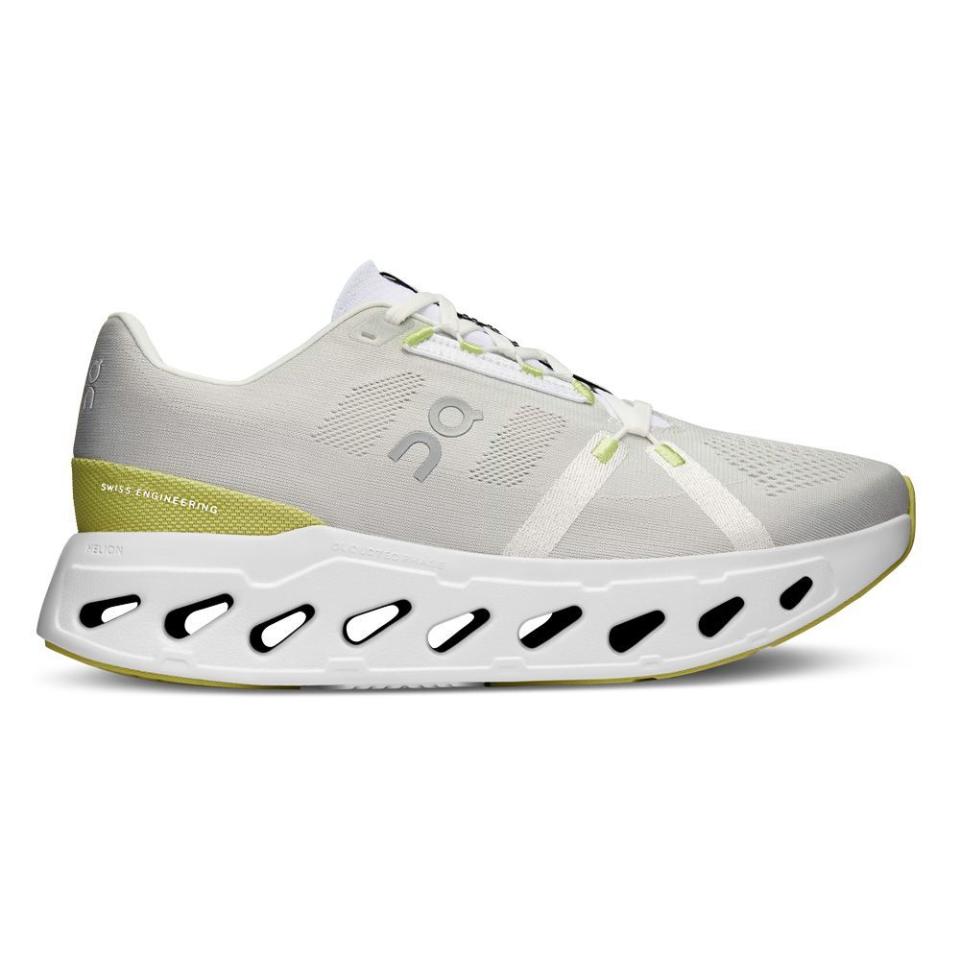
Cloudeclipse
on.com
$180.00
The brand new On Cloudeclipse has already won the RW Gold Medal as one of our highest-rated shoes from wear testers in recent history. Beginner’s luck or not, there’s plenty to love about this beautifully balanced, go-fast trainer.
An ultra-padded “super trainer,” the Cloudeclipse combines a tall stack of soft, responsive foam with a midsole plate—On calls it a “Speedboard”—that stabilizes the foam and adds responsiveness to the platform. The resulting ride is “soft and peppy, but still controlled,” according to Runner’s World test editor Morgan Petruny. “It doesn’t feel too wobbly or unpredictable underfoot.”
Likewise, RW senior newsletter editor Pavlína Černá said the Cloudeclipse deposed Saucony’s Triumph 21 as her favorite training shoe on the market right now. “[It’s] cushioned, but doesn’t let my foot sink,” Černá said. “It has a forward-push, but doesn’t force me to go faster than I want to. Simply perfect!”
The mesh upper was adequately wide for our wear testers and breathable as well, although Petruny noted that its lightweight construction meant that runners with narrow feet may suffer from a sloppy fit if they aren’t able to tighten the laces enough.
Generally speaking, you want to save your “fast shoes” for “fast days”—tempos runs, track workouts and races. With the Cloudeclipse, you can wear your go-fast shoe on every single training run.
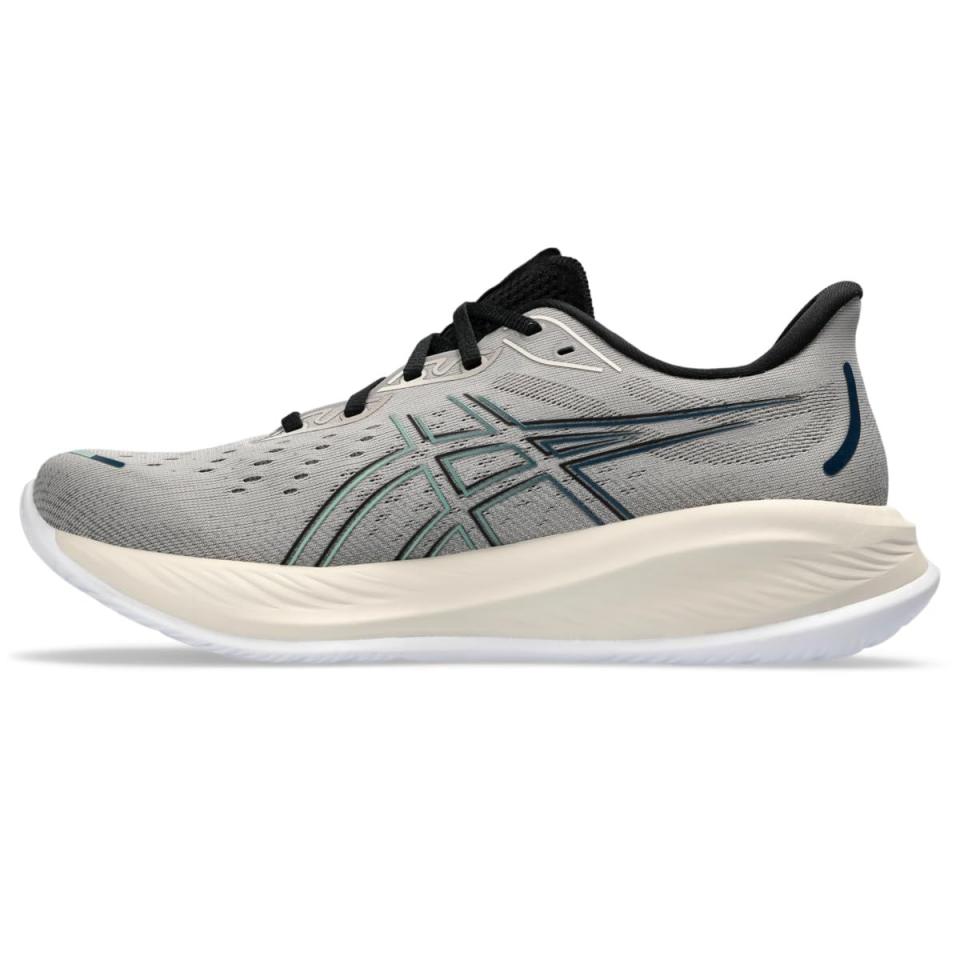
Gel-Cumulus 26
amazon.com
$139.95
Asics has always been great at making shoes that feel comfortable from the moment you step into them, and the Gel-Cumulus 26 is no exception. In fact, two of six RW wear testers who tried it said the updated Gel-Cumulus was the most comfortable shoe they’d ever worn.
This neutral trainer puts plush foam in all the right places: in the tongue, around the heel counter, and in its thick, Ortholite sockliner. The engineered mesh construction also feels soft against your foot, and the shoe breaths well despite having a more substantial upper than many trainers nowadays.
Once you’re on the run, the Gel-Cumulus 26 feels quintessentially Asics, for better or worse. There’s plenty of cushioning at the heel, including a little bit of gel, so wear testers gave the shoe high marks for taking the edge off of the initial impact. But Asics trainers tend to lack flexibility, and testers observed that same quality here.
“My foot didn’t roll as nicely from the heel to the toe like I’ve experienced in other shoes,” said one wear-tester.
The shoe’s relative stiffness can be a blessing for runners with nagging lower leg and foot issues, though, as well as those who prefer a sturdier platform for pounding the pavement. Optimized for comfort over energy return, the Gel-Cumulus 26 is better-suited to regular base mileage than up-tempo work.
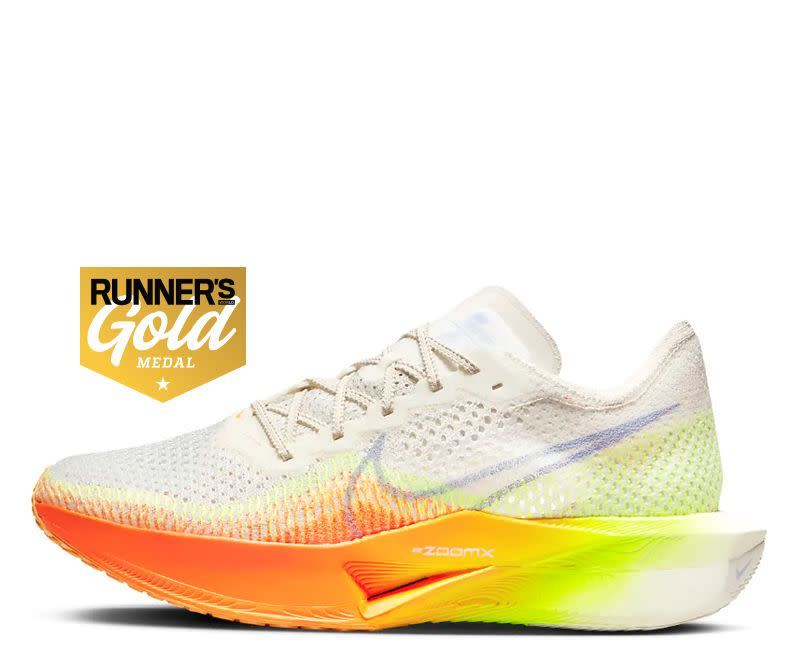
Vaporfly 3
dickssportinggoods.com
$259.99
Nike overhauled the Vaporfly from the rubber up, looking to make the third version the lightest yet. In our men’s size 12, we see only a 0.1-ounce drop from version 2 (our pink pair of the first Next% was 0.4 ounces lighter still). So, it’s not the lightest ever, but it’s still lighter than competitors like the Asics MetaSpeed Sky+, Saucony Endorphin Pro 3, New Balance FuelCell SuperComp Elite v3, Adidas Adizero Adios Pro 3, and Puma Deviate Nitro Elite 2.
One attempt to shave weight came in the way Nike shaped the midsole. It’s still using the same Peba-based material for the foam (Nike calls it ZoomX), which delivers top-of-the-line energy return. That foam is already lightweight, but Nike added a cutout on the lateral sidewall—your foot doesn’t need support there—and a small channel under the midfoot to reduce material and shave a couple grams.
The shoe is also equipped with a carbon-fiber plate. This high-tech combination of plate and foam allows elite marathoners to race under a five-minute pace, but it’s not just for the pros. Even at slower speeds, the shoe still feels exceptionally propulsive and energetic, making every stride a little more efficient and less taxing. Overall, it just might be the speediest and bounciest shoe we’ve tested yet.
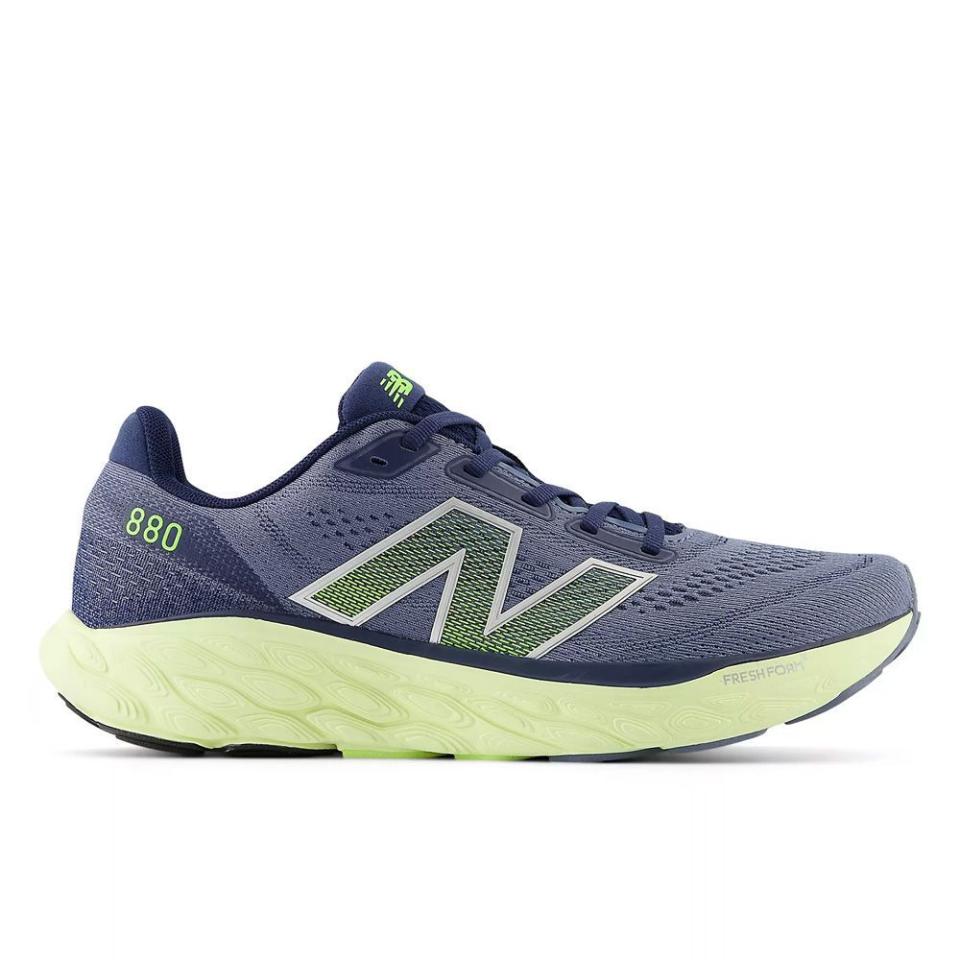
880v14
newbalance.com
$140.00
The previous two versions of the New Balance 880 broke from brand tradition, adding cushioning and weight to fatten up the company’s historically svelte and responsive neutral trainer. In 2024, the 880v14 offers a pleasant surprise for classic 880 fans who have been yearning for a return to fleet-footed form. The newest design is more than 1 ounce lighter than its predecessor, thanks to more judicious use of outsole rubber and a single-layer Fresh Foam X midsole.
We’ll have a full write-up on the 880v14 once our wear testers finish putting it through its paces, but so far we’re loving the more responsive ride. The combination of a lighter midsole and lower heel-toe offset—8mm, down from 10mm in the 880v13—means the new shoe feels more natural on your foot. “It’s still not a springy experience underfoot, but it responds well enough to throw in a few mid-run surges or post-run strides,” Petruny said.
In addition to being great for high-mileage runners who want a reliable trainer that will still feel great at mile 300, the 880v14 sports a generously sized forefoot for runners with wide feet.

Kinvara 14
amazon.com
120.00
Saucony wanted the Kinvara 14 to be more of a “do-it-all” shoe that could run the gamut as a lightweight daily trainer and even a budget racer. For that reason, the brand added 3mm of cushioning, giving the midsole a similar setup to its hallmark neutral daily trainer (the Ride). But Saucony also lightened this version for the start line by borrowing the same airy, fishnet-like mesh from its top-tier speedy model (the Endorphin Pro 3).
“This shoe is very well-balanced for an everyday comfortable ride that can still respond if you want to drop those last miles of your long run with a little bit of extra spice,” said one tester. “The work is on you to keep this shoe upright and get your foot on the ground in an efficient way. If you need extra support and guidance, look elsewhere.”
Since both shoes use Pwrrun foam and a Pwrrun+ sockliner, it’s not surprising that the Kinvara 14 feels like a stripped-down version of the Ride 16. The experience is nimbler and firmer underfoot—one that’s fun because it’s lean and fast and snappy, not bouncy and squishy-soft.
Full Saucony Kinvara 14 Review
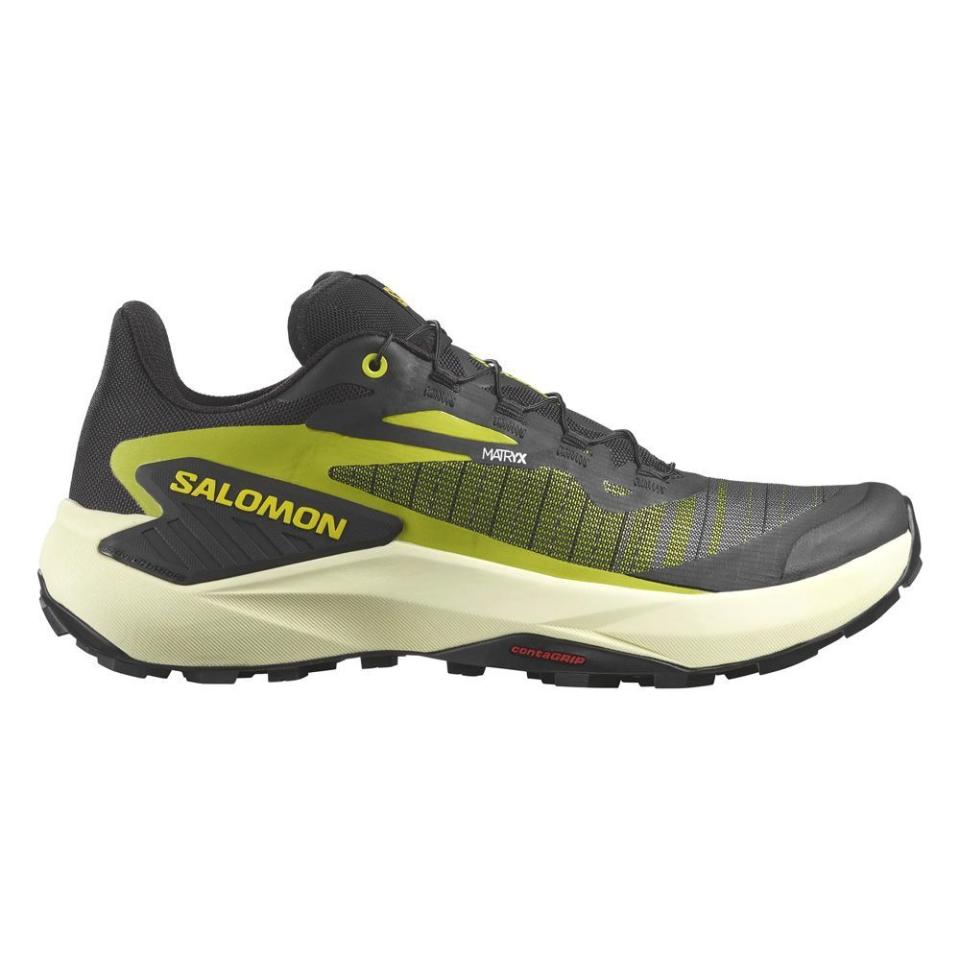
Genesis
salomon.com
$150.00
If the trails are calling and you must go, the Salomon Genesis is a favorite among hardcore mountain athletes and budding trail runners alike. Its Contragrip outsole features chevron-shaped 4.5mm lugs, which claw into loose and sloppy terrain to keep you upright and injury-free. RW video editor Pat Heine-Holmberg recently used the shoe at Tor de Géants, a 205-mile trail race through the mountains of Italy.
“The Genesis gripped the dry, dusty rocks at high elevation as we climbed alpine passes in excess of 30 percent, and ran down equally steep descents,” Heine-Holmberg said.
The shoe’s midsole is on the firm side, Heine-Holmberg noted, making it a durable option for runners who want to use it to blend road and trail mileage. By reducing the amount of space between the outsole lugs, Salomon also made the shoe more useful on the road by avoiding the squirmy feeling of spaced-out lugs underfoot.
It still has some padding in the midfoot, though, and the energy foam blend in the Genesis is lighter and springier than the company’s traditional off-road midsole foam. As for the upper, a thick, protective toe cap and durable Matryx knit construction keeps your foot safe and secure. The shoe also drains well, Heine-Holmberg noted, so feel free to blast right through water crossings in this ready-for-anything trail shoe.
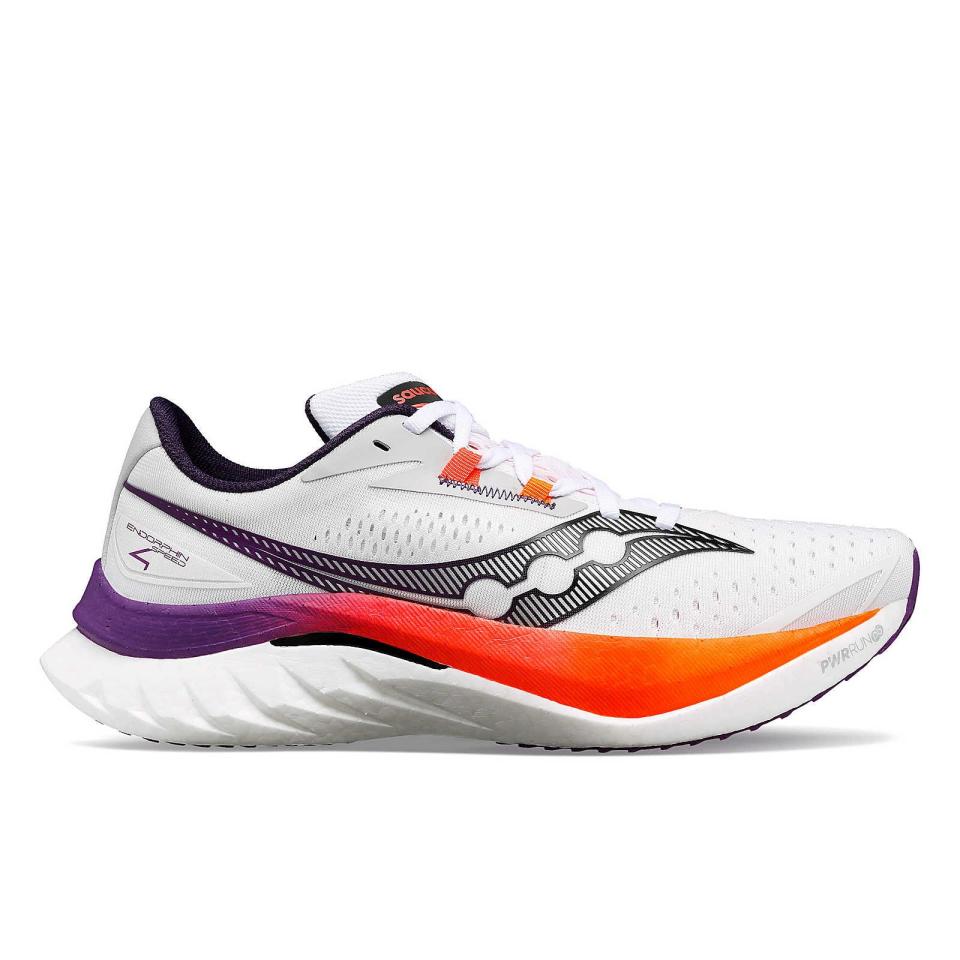
Endorphin Speed 4
saucony.com
$170.00
The Saucony Endorphin Speed 4 dares to ask the question: “What if you could push for a new PR every day?” Many runners alternate between easy to moderately paced training runs and sessions where they push themselves, and have a shoe for each purpose. The daily trainer, which you wear on easy days, tends to feel less exciting underfoot but leaves your legs fresher at the end of the run. A peppier, more aggressive shoe risks getting you injured if you wear it day-to-day.
The Endorphin Speed 4 bridges the gap between trainer and racer by shoving a lot of midsole foam beneath your foot—just 4mm shy of Nike’s towering Vaporfly 3—and delivering seemingly bottomless cushioning. Saucony’s PWRRUN PB foam feels supple at touchdown but firms up to deliver high energy return, and a nylon midsole plate keeps the tower of lightweight, springy foam stable.
“I’ve been using the Speed 4 for marathon base building and all kinds of workouts: fartleks, tempos, race-pace intervals,” said RW test editor Amanda Furrer. “It lets me feel a little super-shoe magic similar to the Pro, without wearing down my carbon fiber–plated pair before race day.”
Saucony also improved the upper, according to most wear testers, widening the toe box while maintaining a secure fit through the midfoot. “I never felt stable in the original (Endorphin) Speeds, but the wider platform on these gives me way more confidence,” one wear tester said. “I also think they’re more cushioned, as longer distances felt easier on my body.”
With a relatively low weight–just over 8 ounces in a men’s size 9–the Endorphin Speed 4 has everything you need to hit PRs out on the road one day and crush a recovery long run the next.
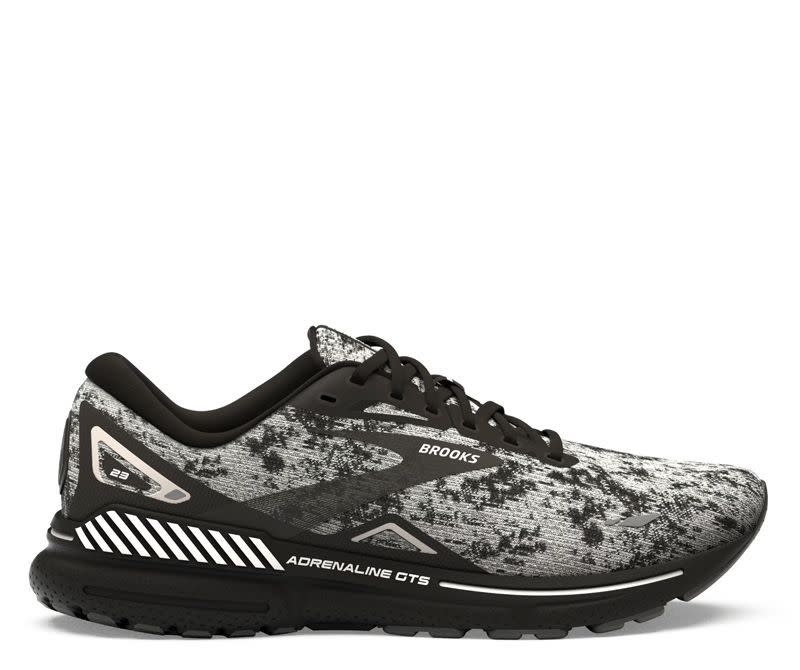
Adrenaline GTS 23
amazon.com
$135.00
The Adrenaline GTS is Brooks’s well-loved stability shoe that has a lighter, less obtrusive GuideRails system, rather than a medial post, to provide support. The 23rd iteration has that same design, which places material along the edges of the sole to keep your feet in alignment. This makes it accessible for both overpronators and neutral runners, since the extra support engages only if you need it.
Overall, the shoe feels slightly softer and smoother than previous models, thanks to the new DNA Loft v2 foam that spans the full length of the midsole. The Adrenaline still provides excellent shock absorption, and the rubber outsole delivers great traction and durability for high-mileage runners.
Q+A With Our Experts
Why should I pay more than $200 for a pair of running shoes?
If you’re looking at this guide (or any of our running shoe guides), you may be wondering why many of these shoes cost more than your average pair of shoes. Setting aside the fact that a lot of things seem to cost more these days, top-tier running shoes often feature new materials and design properties that cost more to produce and deliver superior performance, both of which allow manufacturers to charge more.
For instance, racing shoes now frequently combine multiple cushioning foams–including custom materials–to help you touch down softer, transition to your toes more smoothly and spring forward with more energy coming back to you. In some cases, these materials are so light that designers can add more padding without adding weight. That’s a big boon for competitive runs, where every ounce matters.
That said, you don’t have to spend a lot of money to get great shoes. Basic options like the Brooks Trace 3 work well for a majority of runners with neutral pronation. If you’re looking for more options, check out our guide to the best affordable running shoes.
Can a running shoe actually make me faster?
Good question! It depends on your timeline. Over the course of a race, a lighter, more responsive shoe can indeed deliver you to the finish line faster than a heavier shoe that returns less energy. Nike spent millions of dollars proving that its Vaporfly 4% made the average elite runner 4 percent quicker, and a string of subsequent world records backed up the claim.
However, we wouldn’t recommend using the lightest, fastest shoes every day. For one thing, that would get expensive, since today’s high-end road racing shoes aren’t cheap and tend to break down quicker than shoes geared toward daily training. Secondly, you might not get the support you need from a lightweight, go-fast shoe, and that could lead to injury.
Despite this, we still talk about day-to-day trainers in terms of how quick or responsive they feel, which is somewhat at odds with the fact that training in a shoe that feels quicker isn’t necessarily going to make you fitter or faster. Why do we do that? Because we love to run, and the sensation of speed underfoot can make running more enjoyable.
Better yet, recent developments in shoe technology are increasingly allowing runners to have fast-feeling shoes that also provide adequate cushioning for daily use, although the combination comes at a premium.
Suffice it to say that outside of race day, you should worry more about comfort and support than the sensation of speed a shoe provides—but if you can afford to have all three, go for it.
What kind of socks should I wear?
No matter what shoes you wear, a soaked pair of cotton socks will ruin your run. The more you spend on your shoes, the more important it is to invest in a few pairs of high-performance running socks.
For everyday use in mild conditions, we like a mix of synthetic fabrics like nylon, polyester and spandex, with thinner weaves shining in hot conditions. For winter, wool is great, but it’s even better with added spandex to help it stretch and fit snugly.
Beyond material, look at the amount of cushioning in your socks—some add additional padding in the heel and forefoot and others are totally flat. Lastly, sock height is purely a matter of preference, but make sure you get something that feels comfortable. That said, we’d recommend quarter or crew socks for trail running to keep debris (and bugs) off of your ankles.
You Might Also Like

